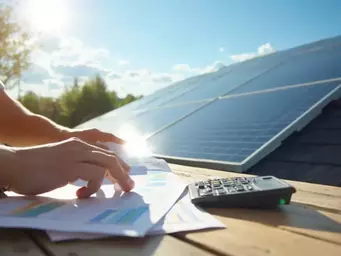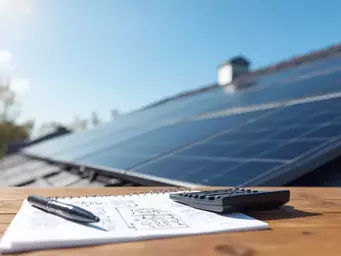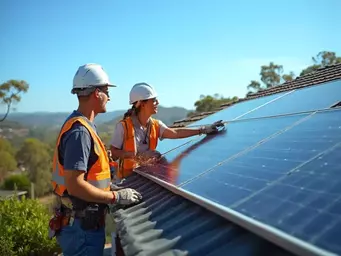1. Understand Energy Needs & Requirements
Analyze current electricity bills, identify peak usage times, and assess your energy consumption habits to determine the right system size.
Unlock expert insights on solar panel installation, energy savings, and government rebates for Australian homes and businesses. Join our community of informed solar enthusiasts!
Posted on: 2025-10-12
By: Evelyn Tran
Are you ready to unlock the potential of solar energy for your home or business? By understanding the fundamentals of solar PV system design, you can make informed decisions that positively impact your energy bills and the environment.
Designing a solar PV system involves a series of crucial steps, from understanding your energy needs to selecting the right components and evaluating the environmental impact. This visual guide outlines the essential stages to help you navigate the process effectively.
Analyze current electricity bills, identify peak usage times, and assess your energy consumption habits to determine the right system size.
Choose appropriate solar panels (mono, poly, thin-film), inverters (string, micro, optimizers), racking, and battery storage solutions.
Consider how your system reduces greenhouse gas emissions and promotes sustainability, contributing to a cleaner planet.
Use online calculators and diagrams to estimate costs, savings, and visualize system components for better planning.
Consult experts for complex decisions, installation nuances, local regulations, and personalized insights to ensure optimal design.
Investigate solar leasing or Power Purchase Agreements (PPAs) to access solar energy with lower upfront costs and flexible arrangements.
Are you curious about how solar power can transform your home or business? You're in the right place! In this guide, I’ll walk you through the essentials of designing a solar PV system. By the end, you’ll have a solid understanding of what a solar PV system is and how it can work for you.
A solar PV (photovoltaic) system is designed to convert sunlight into electricity. This technology is not just a trend; it's a vital step toward sustainability and energy independence! By harnessing the sun's power, we can reduce our reliance on fossil fuels and lower energy costs in the long run. For more detailed information on the installation of photovoltaic systems and code compliance, you can refer to resources like Installation of Photovoltaic Systems: Code Compliance Brief.
Solar PV technology utilizes solar panels made of semiconductor materials that absorb sunlight and generate electricity. The benefits of implementing a solar PV system include:
With these advantages, it's easy to see why solar energy is becoming a preferred choice for many Australians.
Solar panels are the heart of your solar PV system. They capture sunlight and convert it into electricity through the photovoltaic effect. The energy generated can be used in several ways: powering your home or business, charging batteries for nighttime use, or feeding excess electricity back to the grid through net metering. Understanding how solar panels work will help you appreciate their critical role in energy generation. At Longi Solar Solutions, we dive deep into the various types of solar panels available so you can find the best fit for your needs! For further reading on photovoltaics, the Whole Building Design Guide (WBDG) offers comprehensive information.
Designing a solar PV system involves several key components. Each part plays a role in ensuring your system runs efficiently and meets your energy needs.
When it comes to solar panels, not all are created equal! It's important to consider different types and their efficiency ratings:
Each type has its pros and cons, so I encourage you to think about your unique energy needs and roof characteristics when making your selection.
The inverter is crucial in converting the direct current (DC) electricity generated by solar panels into alternating current (AC) electricity used in homes. There are a few types of inverters to consider:
Every inverter type has its own characteristics, so understanding your specific needs will help guide your choice.
Racking systems hold your solar panels in place, so selecting the right mounting option is essential. Here are some common types:
When choosing a racking system, consider your roof type, local weather conditions, and the aesthetic look you desire.
Battery storage systems can store excess energy generated during the day for use at night or during cloudy days. This adds reliability and maximizes the benefits of your solar PV system. Here are some battery types to consider:
Choosing the right battery will depend on your energy needs and budget. I always encourage my clients to think about how much energy they wish to store for the best performance!
Designing your solar PV system is a journey that involves several key steps. Let’s dive into these important stages to ensure you have the perfect setup!
Did you know? When selecting solar panels, focusing on their efficiency ratings can significantly impact your energy output. For instance, monocrystalline panels, while often pricier, typically offer higher efficiency and performance, especially in limited space. Investing in the right panel type can enhance your system’s overall longevity and effectiveness!
A solar PV (photovoltaic) system converts sunlight into electricity, providing sustainable energy for homes and businesses. It helps reduce reliance on fossil fuels and lowers energy costs.
Key benefits include reduced energy bills, positive environmental impact by lowering carbon emissions, increased property value, and access to government incentives and rebates.
There are monocrystalline panels (high efficiency, good for limited space), polycrystalline panels (cost-effective, slightly lower efficiency), and thin-film panels (lightweight, flexible, generally less efficient).
The inverter converts the direct current (DC) electricity generated by solar panels into alternating current (AC) electricity, which is what most household appliances use. Different types like string inverters, microinverters, and power optimizers cater to various system needs and shading conditions.
Battery storage systems store excess solar energy generated during the day for use at night or during periods of low sunlight, enhancing the system's reliability and maximizing energy independence.
To determine the right size, you need to analyze your current electricity bills, identify peak energy usage times, and assess your overall energy consumption habits. This ensures the system is tailored to your specific demands.
You can refer to authoritative sources such as the Installation of Photovoltaic Systems: Code Compliance Brief for code compliance details, the Whole Building Design Guide (WBDG) for comprehensive photovoltaics information, and the National Renewable Energy Laboratory (NREL) for technical reports and research.
As you embark on your journey to design a solar PV system, it’s crucial to take a step back and summarize the key aspects that will guide you. Understanding the fundamentals can make a significant difference in your decision-making process. At Longi Solar Solutions, I’m here to help you navigate this exciting venture with confidence!
First and foremost, you need to have a clear grasp of your energy needs and how they align with the requirements of a solar PV system. This understanding is vital for creating a system that meets your specific demands. Here are some key takeaways to consider:
Another important aspect is the selection of components. Your choice of solar panels, inverters, and battery storage can greatly influence system performance and longevity. Don’t overlook the environmental benefits—designing a solar PV system not only reduces your carbon footprint but also fosters sustainability within your community!
Knowing your energy consumption habits is the cornerstone of effective solar system design. Take time to analyze your electricity bills and identify peak usage times. This insight will enable you to design a system tailored to your lifestyle.
Choosing the right components can seem daunting, but remember that each part plays a critical role in your system’s efficiency. For example, selecting high-quality solar panels can lead to better energy production over the lifespan of your system. Additionally, proper sizing ensures that your system will meet your needs without overextending your investment. For more technical insights, you can review publications from institutions like the National Renewable Energy Laboratory (NREL).
It’s essential to consider how your solar PV system will impact the environment. Not only does solar energy reduce greenhouse gas emissions, but it also promotes a sustainable future. By designing an efficient system, you're contributing to a cleaner planet and encouraging others to follow suit. Together, we can create a brighter future!
Once you've got a solid grasp of the basics, it’s time to take the next steps towards engaging with solar energy. There are several tools and resources available to assist you:
Equipped with these tools, you can make informed decisions that align with your energy goals. Remember, seeking professional help can save you time and ensure that your system is designed to perfection!
There are numerous calculators and interactive tools available online that can simplify your planning process. These resources can help you estimate costs, energy savings, and even payback periods, making it easier to visualize your investment.
Don't hesitate to reach out to professionals when you encounter complex decisions. Whether it’s understanding the nuances of installation or navigating local regulations, expert guidance can be invaluable. At Longi Solar Solutions, I’m here to support you every step of the way!
Finally, consider exploring financial options like solar leasing or Power Purchase Agreements (PPAs). These arrangements often involve lower upfront costs and can be a great way to access solar energy without the full investment burden. It’s all about finding a solution that works best for you!
Here is a quick recap of the important points discussed in the article:

 Ready to unlock the potential of solar energy for your home? Understanding the financial landscape o
Ready to unlock the potential of solar energy for your home? Understanding the financial landscape o
 As you contemplate the shift to solar energy, consider this: a comprehensive understanding of the co
As you contemplate the shift to solar energy, consider this: a comprehensive understanding of the co
 Choosing the right solar installer can significantly impact your renewable energy journey. Are you r
Choosing the right solar installer can significantly impact your renewable energy journey. Are you r